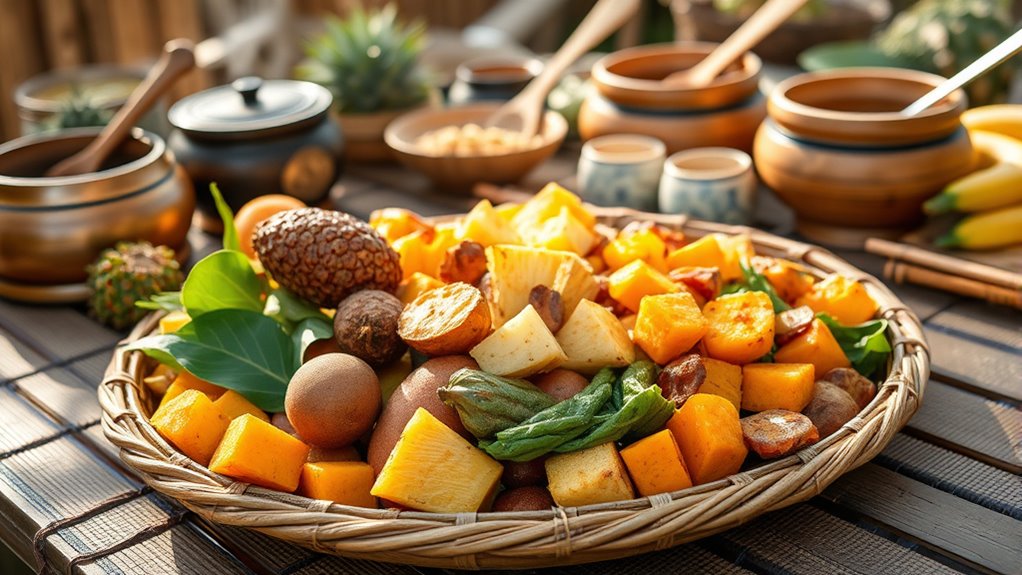Fijian cuisine blends indigenous ingredients, Indian spices, and colonial influences, creating vibrant dishes. You’ll find root vegetables like sweet potatoes and taro paired with fresh seafood, coconuts, and bold spices in curries, stews, and raw fish dishes like Kokoda. Traditional methods like the earth oven (lovo) and steaming preserve authentic flavors. Exploring these rich culinary traditions reveals the cultural significance and coastal bounty that define Fiji’s food scene—stay tuned for more tasty details.
Key Takeaways
- Fijian cuisine features root vegetables, fresh seafood, and coconut milk, blending indigenous ingredients with Indian spices like cumin and turmeric.
- Traditional preparation methods include the lovo earth oven, steaming, roasting, and wrapping foods in leaves to preserve authentic flavors.
- Iconic dishes such as Kokoda, Fish Suruwa, and Palusami highlight seafood and coconut-based flavors central to Fijian culinary identity.
- Coastal communities emphasize seafood delicacies like sea urchin (Cawaki) and marinated raw fish, reflecting maritime heritage and resourcefulness.
- Modern Fijian cuisine incorporates health-conscious modifications, fresh vegetables, and traditional ingredients during celebrations and social gatherings.
Staple Ingredients in Fijian Cooking
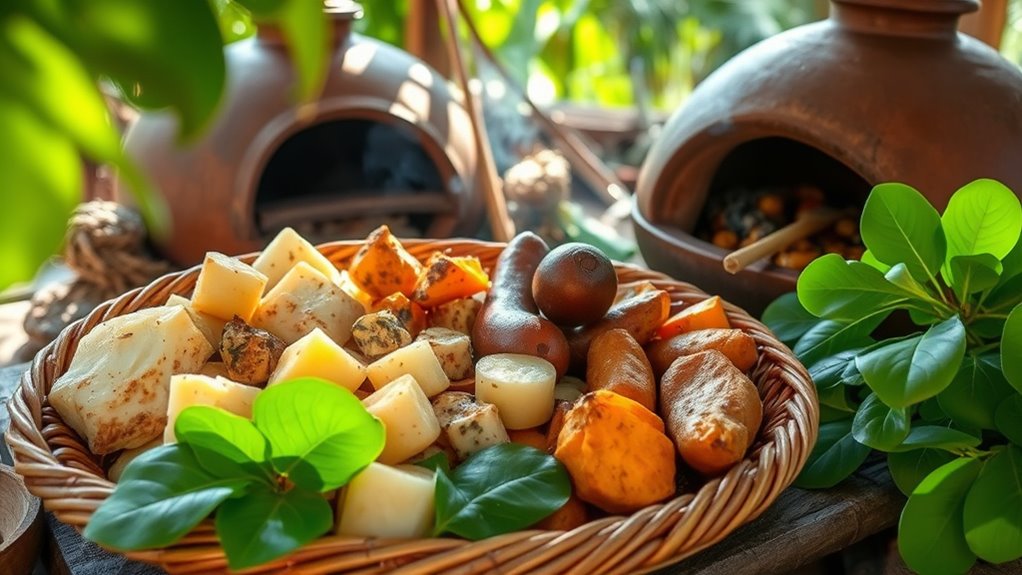
Fijian cuisine centers around a few key ingredients that define its flavors and traditions. You’ll find root vegetables like sweet potatoes, cassava, and taro at the heart of many dishes, providing energy and texture. Fish is another staple, often prepared fresh or cooked in traditional styles, giving the cuisine its seafood-rich character. Coconut milk is essential, adding richness to stews, curries, and raw fish dishes like Kokoda. Duruka, known as Fijian asparagus, is a unique vegetable that enhances various meals. Spices such as cumin, turmeric, and garam masala influence curry recipes, reflecting Indian culinary influence. These ingredients form the foundation of Fijian cooking, blending local produce with imported flavors for a vibrant, diverse cuisine.
Traditional Methods of Food Preparation
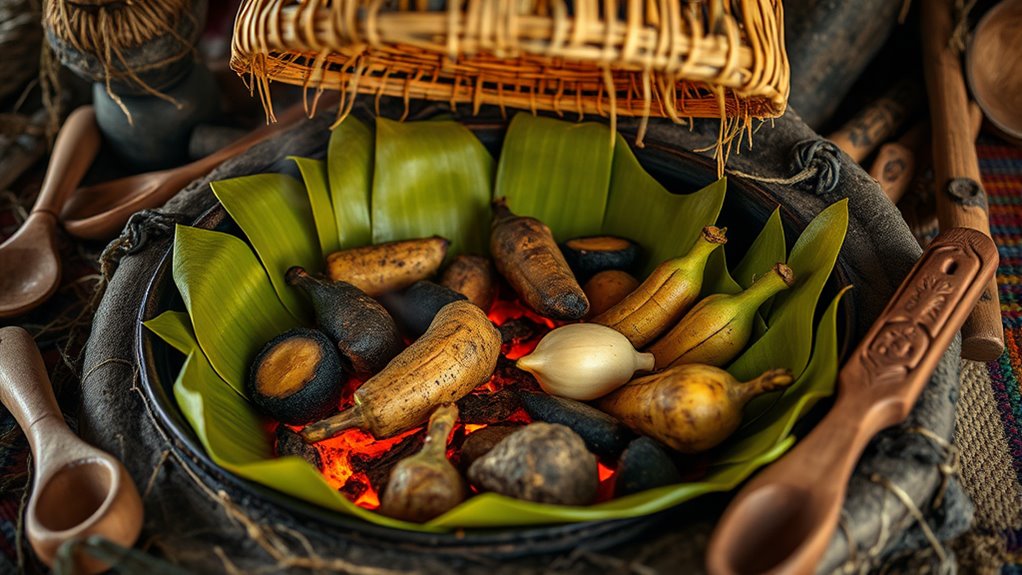
Traditional food preparation methods in Fiji showcase a deep connection to the land and sea, using techniques passed down through generations. One common method is the *lovo*, an earth oven where you wrap food in banana leaves and bake it underground on hot stones. This method infuses flavors and creates tender, smoky dishes perfect for celebrations. Another traditional style is steaming fish inside taro leaves with coconut milk, which preserves moisture and enhances taste. These methods often involve simple tools like stones, leaves, and fire, emphasizing natural flavors. Additionally, the use of cooking techniques reflects a rich cultural heritage that values sustainability and resourcefulness. Here’s a quick overview:
| Method | Ingredients & Tools | Dish Examples |
|---|---|---|
| Lovo | Banana leaves, hot stones | Meats, vegetables, seafood |
| Steaming | Taro leaves, coconut milk | Fish-in-lolo, taro leaves |
| Roasting | Open fire, skewers | Cured meats, seafood |
Iconic Dishes and Flavors of Fiji

Fiji’s cuisine is renowned for its vibrant flavors, especially in its classic curries and seafood delicacies. You’ll find a perfect blend of spices like turmeric and cumin in the curries, while fresh seafood like fish and sea urchin highlight the islands’ coastal bounty. These dishes showcase the rich culinary heritage that makes Fijian food uniquely delicious. Additionally, the use of AI in culinary arts is transforming recipe development and food presentation, offering innovative ways to experience traditional flavors. AI-driven culinary innovation
Classic Fijian Curries
Classic Fijian curries are a vibrant fusion of indigenous ingredients and Indian spice influences, resulting in bold, flavorful dishes that stand out in the Pacific culinary scene. You’ll notice the rich use of coconut milk, which creates a creamy base that balances the spices. Typical ingredients include fish, chicken, or vegetables like taro and cassava, simmered with cumin, turmeric, and garam masala. These curries often feature fresh chili for heat and garlic or ginger for depth. You might enjoy Fish Suruwa, a white fish curry infused with coconut milk and spices, or Chicken Curry with a fragrant, aromatic sauce. The dishes are usually served with rice or flatbreads like roti, making them hearty, satisfying, and integral to Fiji’s culinary identity. To enhance these dishes, chefs often incorporate authentic ingredients that reflect Fiji’s diverse cultural influences.
Unique Seafood Delicacies
Fiji’s rich coastal waters offer a treasure trove of unique seafood delicacies that highlight the islands’ vibrant culinary culture. You’ll find a variety of fresh, flavorful options that showcase Fiji’s connection to the sea. Immerse yourself in dishes like Cawaki, a prized sea urchin enjoyed raw or grilled, or indulge in Kokoda, where mahi-mahi marinates in coconut milk and citrus. Fish Suruwa combines tender fish with spices and coconut, served with rice or roti. You might also encounter Palusami, with taro leaves folded in coconut cream and herbs. Coastal communities treasure these seafood treats, often gathered from reefs or caught fresh daily, adding authenticity and richness to Fiji’s culinary identity.
- Cawaki (sea urchin), enjoyed raw or grilled
- Kokoda (marinated raw fish in coconut milk)
- Fish Suruwa (spicy fish curry)
- Palusami (taro leaves in coconut cream)
- Canned or grilled seafood snacks
The Fusion of Cultural Influences in Fijian Cuisine
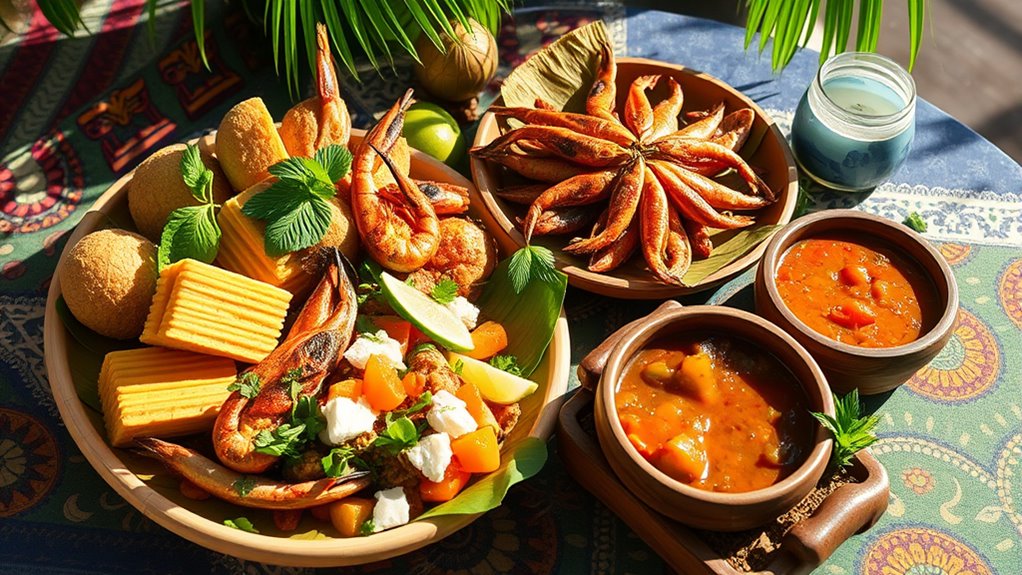
You’ll notice how Fijian cuisine blends indigenous ingredients with Indian spices, creating unique curry flavors and flatbreads like roti. Colonial influences also introduce Oceanic tastes, such as traditional cooking methods and seafood dishes. This mix reflects Fiji’s diverse history and multicultural society, shaping its vibrant culinary scene. Additionally, the incorporation of traditional cooking methods adds depth and authenticity to Fijian dishes, showcasing the island’s rich cultural tapestry.
Indigenous and Indian Blends
The rich tapestry of Fijian cuisine vividly reflects the blending of indigenous traditions with Indian culinary influences, creating a unique and vibrant food culture. You’ll notice how local ingredients like taro, coconut milk, and fresh fish merge seamlessly with Indian spices and cooking techniques. This fusion results in flavorful curries, such as Fish Suruwa, seasoned with cumin, turmeric, and garam masala. Roti and other flatbreads, introduced by Indian immigrants, are now staples alongside traditional Fijian dishes. Spices are used generously, enhancing the natural taste of seafood, root vegetables, and vegetables. The influence is also evident in the use of coconut milk and chili, bringing a rich, spicy, and aromatic dimension to many dishes. Additionally, the integration of AI in media and entertainment has led to innovative culinary storytelling and virtual cooking experiences that showcase this vibrant fusion. This culinary blend exemplifies Fiji’s multicultural identity and shared history.
Colonial and Oceanic Flavors
Colonial and Oceanic influences have profoundly shaped Fijian cuisine, blending European, Polynesian, and Melanesian flavors into a vibrant culinary tapestry. You’ll find dishes that combine native ingredients with colonial spices and cooking methods, creating unique flavors. For example, the use of coconut milk and root vegetables merges traditional Fijian food with Indian spices brought by labor migrants. Polynesian methods like the lovo underground oven coexist with colonial-style curries and baked goods. This fusion reflects Fiji’s multicultural history and diverse community. The table below highlights key ingredients and techniques that illustrate this blend:
| Ingredients | Techniques |
|---|---|
| Coconut milk | Lovo (earth oven) |
| Root vegetables | Steaming in taro leaves |
| Indian spices | Curries and flatbreads |
| Fresh seafood | Raw and grilled dishes |
| Colonial spices | Baked and marinated |
Additionally, the use of colonial spices in traditional dishes showcases how colonial history continues to influence Fijian culinary practices.
Unique Snacks and Sweets in Fiji

Have you ever tasted Fiji’s unique snacks and sweets that showcase the island’s rich culinary heritage? You’ll find treats that highlight local ingredients and traditional methods. For example, Vakalolo is a steamed dessert made from grated cassava, coconut, ginger, sugar, and cloves, wrapped in banana leaves. Purini is a burnt sugar pudding loved for its caramelized flavor. Cassava-based sweets are common, reflecting the importance of root crops. You might also enjoy pies filled with custard, pumpkin, or pineapple, perfect for between meals. Finally, Steamed coconut puddings with caramelized sugar and spices offer a sweet, comforting experience. These snacks and desserts are integral to Fiji’s culinary identity, often enjoyed during gatherings and special occasions. Incorporating traditional methods into preparation helps preserve the authentic flavors of these treats.
The Role of Food in Fijian Society and Celebrations
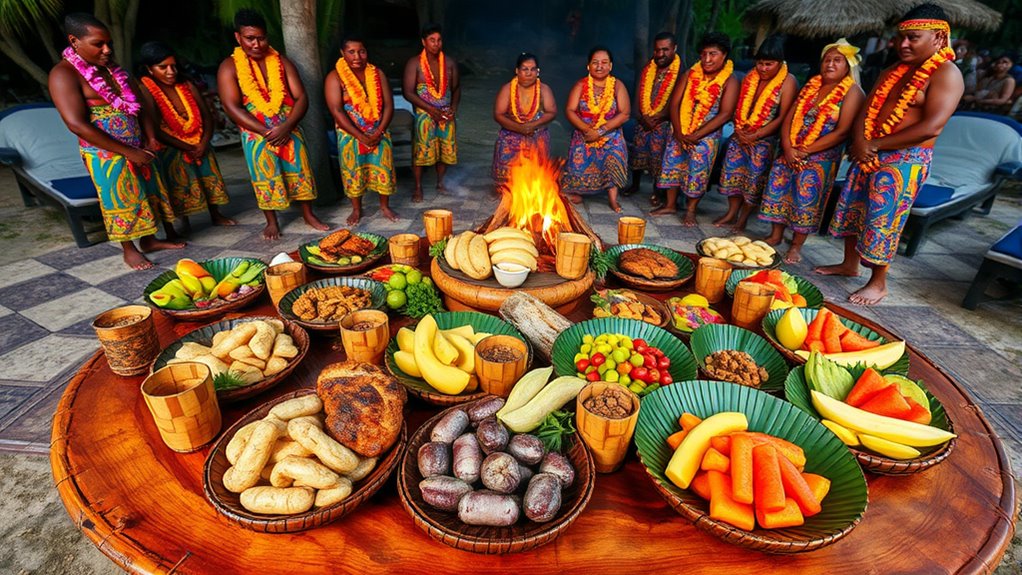
Food plays a central role in Fijian society, serving as a symbol of hospitality, community, and cultural identity. When you visit a Fijian home or attend a celebration, sharing a meal is essential. Traditional feasts, like lovo gatherings, bring people together to cook and enjoy food collectively, strengthening bonds. Food also marks important events such as births, weddings, and welcoming guests, showing respect and generosity. Special dishes like kokoda or fish suruwa are prepared to honor occasions or guests. Cooking and sharing meals foster community spirit and uphold traditions passed down through generations. In Fiji, food isn’t just sustenance; it’s a crucial part of social life that unites people and celebrates their diverse cultural heritage. Additionally, understanding the benefits of raw food can enhance appreciation for the natural ingredients used in traditional Fijian cuisine.
The Significance of Seafood and Local Delicacies

Seafood holds a vital place in Fijian cuisine because the islands’ extensive reefs and coastal waters provide abundant, fresh fish and marine delicacies. You’ll find that fish like mahi-mahi, tuna, and grouper are staples, often prepared in traditional ways such as in lovo or steamed in taro leaves with coconut milk. Local delicacies highlight the ocean’s bounty and include:
- Cawaki (sea urchin), enjoyed raw or grilled on reef islands
- Kokoda, where raw fish is marinated in citrus and coconut milk
- Fish Suruwa, a spicy fish curry with Indian-influenced spices
- Edible sea urchins, considered a delicacy in coastal communities
- Fish in Lolo, steamed fish wrapped in taro leaves with coconut
These dishes embody Fiji’s rich maritime heritage and cultural significance, connecting communities to the sea. Educational resources are available to deepen understanding of the traditional methods used in preparing these dishes.
Health Aspects and Modern Adaptations of Fijian Food

Despite its rich culinary heritage, modern Fijian cuisine increasingly emphasizes health-conscious choices by incorporating more fresh vegetables, lean proteins, and reduced amounts of saturated fats. You’ll find dishes now feature more salads with tropical fruits and vegetables like cucumber, tomato, and greens, adding essential nutrients. Seafood remains central, but preparation methods shift toward grilling or steaming instead of frying. Traditional ingredients like taro, sweet potato, and coconut milk are used more sparingly to cut down on calories and saturated fats. Modern adaptations also include healthier versions of popular dishes like kokoda, with less coconut milk and more fresh citrus. These changes help preserve Fiji’s culinary identity while promoting a balanced diet, aligning traditional flavors with contemporary health standards. Incorporating food safety practices is also essential to ensure the quality and freshness of ingredients used in these healthier dishes.
Frequently Asked Questions
How Do Traditional Fijian Cooking Methods Influence Modern Cuisine?
Traditional Fijian cooking methods, like the lovo, deeply influence modern cuisine by inspiring dishes cooked using earth oven techniques or similar methods. You’ll notice the flavors and communal spirit carry over into contemporary recipes, blending indigenous methods with new ingredients and global influences. These techniques promote a sense of tradition, community, and authenticity, making modern Fijian dishes rich in history while embracing innovation.
What Are the Most Popular Fijian Spices Used in Everyday Dishes?
You’ll find cumin, turmeric, and garam masala as the stars of everyday Fijian dishes, much like a spice symphony. I once watched a local cook sprinkle turmeric into a curry, transforming it into a vibrant, fragrant masterpiece. These spices, brought by Indian immigrants, now flavor everything from fish curries to vegetable stews. They add warmth, depth, and complexity, making your meals truly memorable.
How Has Indian Immigration Shaped Fijian Curry Recipes?
Indian immigration has deeply influenced Fijian curry recipes by introducing spices like cumin, turmeric, and garam masala, which are now essential. You’ll find these spices used in traditional dishes like Fish Suruwa and curries, adding rich flavors and complexity. They blend seamlessly with local ingredients such as coconut milk, root vegetables, and seafood, creating a fusion that reflects Fiji’s multicultural culinary heritage.
What Are Common Vegetarian Options in Fijian Cuisine?
When it comes to vegetarian options in Fijian cuisine, you’re spoiled for choice. You’ll find delicious stews like rourou, made from taro leaves simmered in coconut milk, packed with flavor. Vegetables such as duruka (Fijian asparagus) and root crops like sweet potatoes and cassava are staples. Many dishes use coconut milk and local spices, proving that you don’t need meat to enjoy hearty, satisfying meals in Fiji.
How Do Fijian Desserts Differ From Other Pacific Island Sweets?
You’ll notice Fijian desserts often focus on root crops like cassava and taro, combined with coconut milk and sugar, creating rich, steamed puddings or cakes like purini and vakalolo. Unlike other Pacific sweets that may emphasize tropical fruits, Fijian treats highlight steamed, coconut-based flavors with ginger and spices. These desserts are often simple, hearty, and communal, reflecting Fiji’s love for sharing and traditional ingredients.
Conclusion
Fijian cuisine beautifully reflects its rich cultural tapestry, blending traditional flavors with modern twists. Did you know that seafood, especially fish and shellfish, makes up over 60% of Fiji’s diet? By exploring these culinary traditions, you gain a deeper appreciation for Fiji’s vibrant food scene. Whether you’re savoring a local delicacy or trying your hand at traditional methods, you’re part of a delicious journey through Fiji’s unique culinary heritage.

